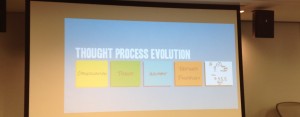 Last night I had the pleasure of attending Boston’s Lean Startup Circle, titled “Sprinting Towards Innovation”. Lead by C. Todd Lombardo the Principal Innovation Catalyst at Constant Contact, the evening was a very hands-on event that focused on a process for innovation. This particular process, typically held over a 5-7 period was condensed into just over an hour so the fire hose was most definitely turned on full bore. The purpose of the process is to generate ideas around solving a particular problem and then come up with simple, inexpensive ways to test the solution before investing a ton of resources building it out. Lombardo laid out a very deliberate but evolving process for innovating that likes most good art, it borrows. In this case, tenets of Agile Development, Customer Development and Lean Startup were all on display. And while the evening covered an incredible amount of ground (you can see the slides here but without the context of the presenter, they may not carry as much value), there were three great insights around brainstorming that keep rattling around my World Series, sleep deprived noggin today.
Last night I had the pleasure of attending Boston’s Lean Startup Circle, titled “Sprinting Towards Innovation”. Lead by C. Todd Lombardo the Principal Innovation Catalyst at Constant Contact, the evening was a very hands-on event that focused on a process for innovation. This particular process, typically held over a 5-7 period was condensed into just over an hour so the fire hose was most definitely turned on full bore. The purpose of the process is to generate ideas around solving a particular problem and then come up with simple, inexpensive ways to test the solution before investing a ton of resources building it out. Lombardo laid out a very deliberate but evolving process for innovating that likes most good art, it borrows. In this case, tenets of Agile Development, Customer Development and Lean Startup were all on display. And while the evening covered an incredible amount of ground (you can see the slides here but without the context of the presenter, they may not carry as much value), there were three great insights around brainstorming that keep rattling around my World Series, sleep deprived noggin today.
Brainstorm Alone First
Alex Faickney Osborn, the father of the brainstorm concept originally posited that once the problem has been stated, participants in a brainstorming session should spend some time creating there ideas for solutions by themselves. Brainstorming is not just a free-for-all of ideas where participants shout out whatever ideas pass through their heads at a given moment. Instead, brainstorming sessions can be made more valuable when individuals are given time to ponder their own solutions before sharing them with the group.
The Power of the Timebox
The concept of timeboxing is a critical component of Agile development. Typically, you will timebox discussions around planning and the entire concept of a sprint is a timebox. When generating ideas for a solution to a particular problem, timeboxing can have two, seemingly opposite effects. First, timeboxing encourages quick thinking or better said, unfiltered suggestion making. Sometimes the best solutions are the ones you don’t over think. By limiting the amount of time for suggestions, you are preventing people from pondering all of the nuances of their solutions which ultimately encourages more suggestions. Simultaneously, by limiting the amount of time for a brainstorm session, you are putting a limit on the number of solutions to consider.
Dot Voting
One of the challenges in a brainstorm session is trimming down the best ideas. The concept of Dot Voting can be very effective at surfacing the best ideas from the group. In Dot Voting, each member of the team is given a fixed number of votes or dots to use for the session. All of the ideas are posted in a visible area and each person places their dots or votes on the idea or ideas they like best. Once all of the votes have been cast, the ideas with the most votes can be identified. If there are still too many ideas to work on, simply repeat the process again and again until you have a manageable list of ideas to develop.
Bonus takeaway: On Prototypes
The final part of the presentation was on prototyping. The end goal of the brainstorm session is to develop simple experiments (in some cases, prototypes) to test out the assumptions inherent in the solutions and/or answer specific questions about a particular solution. These prototypes can take many forms and prototypes can be simple to produce (so you can produce them quickly). They just need to address a specific question that you have about a solution. Lombardo illustrated this point with a fantastic video from Ideo:








